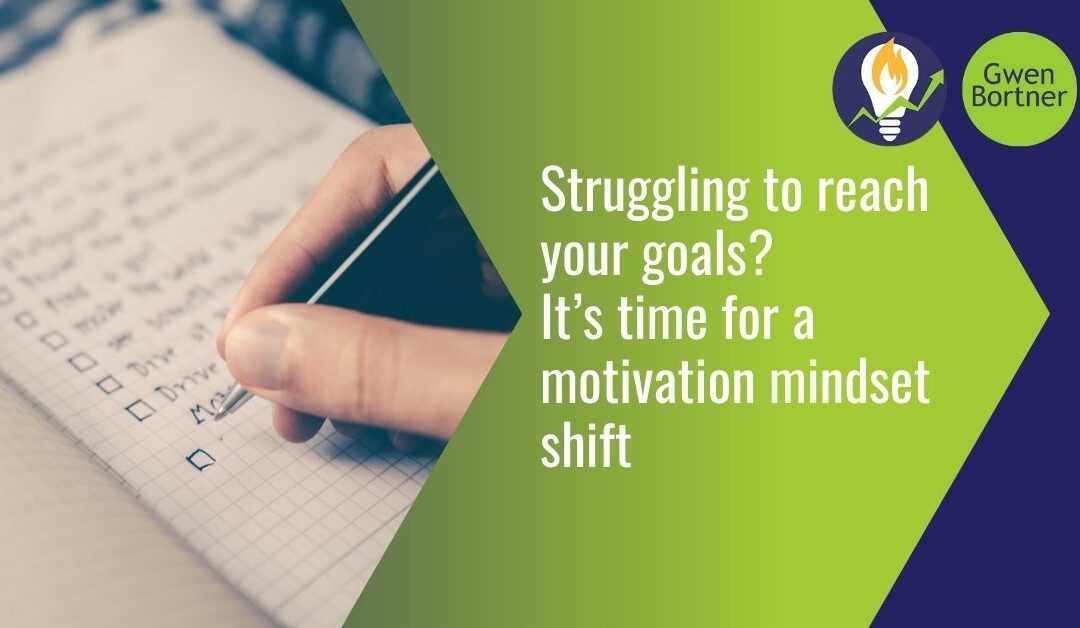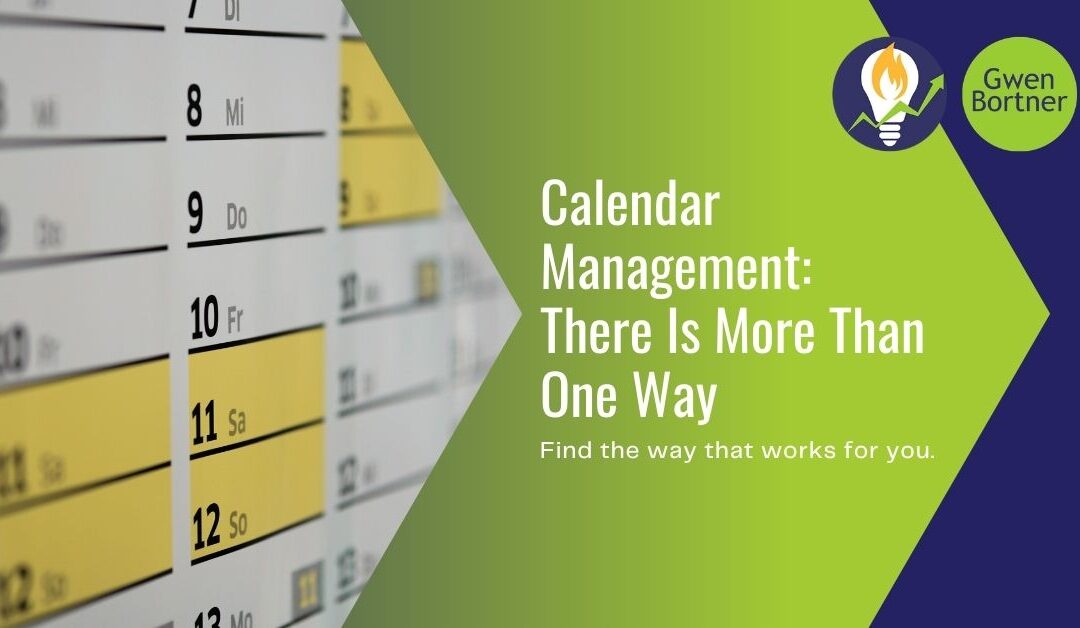
by Gwen Bortner | Tasks & Goals, Training & Instruction
How happy are you with the way you typically set goals for your business? Do you keep your goals once you’ve set them, or do you struggle to follow through? In my last post, I outlined the crucial first step in the goal-setting process: quarterly review. Today, I’m walking you through what to do once you’ve completed your review, and you’re ready to sit down and set your goals.
Most people are actually pretty bad at setting goals: they tend to default to one of two options, neither of which are great. The first option is to set a goal that is so easy to reach, that there’s no real challenge involved. Then they don’t end up seeing any real growth, because the goal wasn’t ambitious enough. With the other option, some folks set goals that are too ambitious, to the point where they’re almost impossible to reach. Then they get easily discouraged because they never feel like they’re getting anywhere. Most entrepreneurs fall into the second category, in my experience.
This is why it’s so important to look at real data before you set your goals, and then to make sure the goals you set are intentional and logical as well as aspirational.
Not One Goal, But Three: Good/Better/Best
Earlier in my career as an entrepreneur and CEO, I participated in Todd Herman’s 90-Day Year goal-setting program. During this time, I learned about the concept of good/better/best goals. I still use this process in my own goal-setting, and I encourage it for my clients as well.
In this type of goal, you have three levels:
- A good goal is one that would yield a satisfactory result, and reaching it isn’t completely out of the realm of possibility. With this type of goal, you should be able to reach it around 80-90% of the time, barring unforeseen circumstances. You should be willing to bet a thousand dollars on reaching this goal, but it shouldn’t be so easy that reaching it is just an absolute default guarantee.
- A better goal is something that will be a stretch, but also still possible. You should definitely feel like you’re pushing yourself to be able to reach this goal, but in the end, you should actually reach it between 40 and 50% of the time. This type of goal is possible, but not easy.
- A best goal is one where if you reached it, you would probably pass out from the excitement. It’s still feasible, but very unrealistic. Reaching a goal like this only happens 5-15% of the time, because several factors have to line up for you to hit that goal. (Note: This is where entrepreneurs often set their only goals, and that’s why they get discouraged because they almost never actually reach those goals.)
Set the Right Types of Goals
Using the data from your review, choose one to three areas of your business that you want to work on for the coming quarter. For each area, you’re going to set a good, better, and best goal.
Before you actually write down your goal, consider this: there are only two types of goals you can set, and you will want to be intentional about the type you choose. Activity goals are things you will do, while outcome goals are results you will see. For example, an activity goal is, “I will write a newsletter every week.” An outcome goal is, “My newsletter will have a 50% open rate every week.” You can control an activity goal, but you can’t fully control an outcome goal.
Both types of goals are valid, but when you’re setting your goals, it’s important to have at least one outcome goal that will positively influence your business. The outcome goal is often just about income, and it will be tied to activities, but the outcome is the goal you should reach for.
Think about it this way: if you set an activity goal, and you do the activity, what happens next? The outcome is uncertain, but if you do not see any positive results from your efforts, you’re stuck in a holding pattern. On the other hand, if you set an outcome goal, you will naturally change up the activities you try until you find the “magic formula” that yields the outcome you were after. You’ll be more likely to achieve success because you were pursuing an outcome rather than checking an activity off your To-Do list.
For each area, you identified to work on, set a good/better/best goal, and try to make sure that most of these are outcome goals.
Check-in: Do these goals feel right for you?
If you have three major outcome goals with good/better/best levels for each one, that’s a good place to start. However, it’s important to take a look at those goals and examine them with a critical eye. Can you reasonably work toward all three goals at one time? Will reaching those goals bring you the growth or stability you’re after in your business? Is it a stretch that will challenge you without overwhelming you? Do these goals line up with your vision and mission?
One final item to consider: Is there a goal that you need to set around your own behavior, that would move your business forward? Maybe you need to look at your finances every week, delegate more work and stay out of it, or thank a different employee for something specific every day. As the CEO of your company, nobody performs an annual review for you, so you’ve got to do it for yourself. Personal development should always be part of your goal-setting process, so while you’re listing your goals, make sure to pick one thing that you could be doing better and add it to the list.
Do you want some support in setting strong goals and holding yourself accountable for working toward them?
Let’s talk about how our Quarterly Tune-Up sessions may be the perfect fit to help you set your goals and keep with them.
Click here for more information to schedule a conversation with Gwen.

by Gwen Bortner | Office Productivity, Tasks & Goals, Tips & Tricks
Setting goals is great – it feels so good to think about the future and make plans for the greatness you will achieve in the coming year. The hard part comes when you start looking back at the goals you set, and you realize you haven’t met any of them. Stop letting yourself down – learn how to actually MEET the goals you set so that you don’t have to feel like a failure any more!
Here are my best tips for achieving the goals you set for yourself, whether they’re for life or business or both!
Tip #1: Understand whether or not this goal REALLY matters to you.
Often when we fail to reach a goal, it’s because we gave them lip service but weren’t truly inspired to reach them. We thought we should set the goal but as it turns out, we don’t want to actually work with it. So the first step is to eliminate all the goals that don’t actually matter. Though this may *feel* a bit like failing at those goals, in reality it’s more like de-cluttering your goal list so you can focus on working towards the things that matter most.
Tip #2: Keep your goal count low.
When you set too many goals at once, you’re focusing on too many things and you don’t get any progress made. Even if you have several goals in mind, choose just a few to focus on at any one time so that you can make real progress. It’s better to check off your goals one at a time because you can use that progress to motivate you to work toward the next goal, rather than pushing yourself to work on too many projects at once and feeling like you’re never going to finish anything.
Tip #3: Partner with someone who has similar goals.
This type of relationship is called an accountability partner, and it can be really helpful to work together with someone who has similar goals to your own. The concept is most familiar in the form of a workout buddy but it can be applied to any goal. The key is to work toward supporting one another and not turn it into a competition.
Tip #4: Work with someone who can help to push you toward reaching your goal.
Instead of an accountability partner (someone who has a similar goal), this tip is more about finding an outside person to motivate you to work on your goal. It might be a partner or friend or it could be someone like a business consultant or coach.
Tip #5: Set 3-Level Goals.
Todd Herman suggests you should give yourself goals at 3 levels: good, better, best. For instance: the best-case scenario is that you want to lose 50 pounds, but good would be 10 and better is 25. If you ONLY set the highest-level goal then it often takes too long to reach it and it’s easy to get discouraged. But when you reach the good or better goal then that can even be what motivates you to push to the next level.
Tip #6: Look for the WOW Mindset.
Instead of looking at how far you have to go, you look at how far you have already come. Instead of, “I’ve still got 9lbs to lose,” think of it like, “WOW, I lost a pound already!” Looking at your goals from the mindset of the progress you’ve made rather than what’s left to do is a way to encourage yourself to keep making that progress. (This is another of Todd Herman’s great ideas!)
Tip #7: Avoid the OW Mindset.
Herman’s final contribution to this post is the “OW Mindset,” or the idea that all too often we focus on what’s left to come instead of on how far we have already climbed. This tip is the companion to the last one; avoid thinking of the “pain” of what’s to come and instead focus on the success of what you’ve already achieved.
Tip #8: Recommit to your goals on a regular basis.
Review your progress, make adjustments as needed, and keep moving forward. This is the foundation of making actual progress – the process of checking up on the progress you’ve made and reminding yourself why you wanted to achieve that goal in the first place.
Sometimes, reaching the truly important goals requires more motivation and resources than you can drum up all by yourself.
If you’d like some help reaching your goals for 2022, I’m offering a free workshop where I’ll be teaching my 3 best strategies for reducing overwhelm and meeting your goals. Click here to sign up!

by Gwen Bortner | Leadership, Tasks & Goals
How many times have you set a goal, personally or professionally, and then felt frustrated when you weren’t able to reach it? Maybe you were really enthusiastic at the beginning, but you lost interest over time. Maybe the goal felt attainable when you set it, but then you just never seemed to get close to actually reaching it.
If you’ve been struggling to reach your goals, chances are it’s because you’re skipping a very important step. Instead of starting the goal-setting process by looking forward to what you hope to reach, instead you need to start by looking back.
My coaching clients and I start our quarterly goal sessions with a thorough, all-day review. After all, you can’t choose where to go next if you haven’t stopped to look around and assess where you are now.
This is the process we follow:
1: Highlights
Start by recording your wins for the prior quarter. No matter how bad you think the last three months were, there are always some wins to be recognized. This sets a positive tone and helps you focus on how to do more of what you and your business does best. Then identify a few key challenges and roadblocks that need to be addressed going forward. Finally, take a few minutes to note any important observations as these can be extremely valuable later in the process.
2: Financial Assessment
Start by looking at your numbers at a higher level than what you do every month, so you don’t get too caught in the weeds. Look at what IS, not what you think might be, using real numbers and real results. Look at sales, customers or clients, income, or whatever other financial metric you think would be valuable to track. Write down where you are for the previous quarter.
3: GEARS Assessment
My coaching clients use my free GEARS assessment to help them get focused on the most important aspects of their business every quarter. We examine goods & services, effective leadership, accountability, resources, and systems together. We also check in on sales and marketing during this time. (Want a free copy of my GEARS assessment to use in your own review? Click here!)
4: Personnel Assessment
In your company, are the right people doing the right job in the right way with the right attitude? If not, then what needs to be fixed or changed? Do you need to let someone go, move someone, find someone new? This may be the most difficult part of the process, especially if you have worked with your people for any length of time, but it’s only through asking ourselves tough questions like these that we are able to move forward.
Time to review & assess.
Once you have completed an extensive review, it’s time to look at what you just outlined: what is your review telling you? Are there areas that stick out as being high-need scenarios? Is there anything that surprises you about the information you gathered? Where should you go next, based on what you’ve found?
Take stock:
- Write down what you have done really well, that you want to continue into the next quarter.
- Now note that area of the highest need for improvement.
- Write down the area that you’re most enthusiastic about working on in the future.
- Write down any big “emergency” problems that need your attention immediately.
Be honest with yourself at this stage, and use the real data from your review to help you take your notes. You’ll probably discover through this process that in some areas, you’re doing better than you thought you were. In others, there may be problems you weren’t aware of until you did this review. That’s why it’s so important to look at actual data and not base your goal-setting off assumptions or memory.

by Gwen Bortner | Tasks & Goals
In my work as a consultant, I talk to my clients about goal-setting all the time. You probably set goals regularly, both formally and informally, but how many of those goals do you actually reach? If you’re having problems in this area, chances are you just need to change your mindset about goal-setting and motivation.
Do any of these scenarios apply to you?
- You set a goal and you feel really excited about it, but only for a short period of time. Eventually, your enthusiasm fizzles out, and you’re left feeling defeated because you couldn’t reach the goal.
- You set a goal but you have no idea how to actually achieve it, so you get overwhelmed and start to think that maybe the goal just isn’t possible for you.
- You feel like you should be setting more goals for your life or business, but you can’t really figure out what those goals should be.
If you saw yourself in any of those scenarios, keep reading, because this post is for you.
Change your WHY
When you set a goal, what is the reason for it? If you can’t think of one, or the reason is because someone else suggested it (you read about it in a blog post, or that’s what “everyone” is doing, or you have seen it work for other people so you assume it will work for you), it may be time to set a new goal. Doing something because that’s what other people expect, or because it seems like the right idea, is rarely going to give you enough motivation to achieve it.
Maybe you DO have a reason for your goal, though. Do you want to earn enough money in your business so you can quit your day job? Do you want to get 100,000 followers on Instagram so you can partner with other brands? Do you want to earn enough money to buy a ski condo for family vacations?
Those are all great goals, and perfectly valid reasons. The problem is, sometimes those reasons just aren’t enough to really motivate you to reach that goal. It’s easy to get comfortable with what you have, which then causes you to lose the motivation to get what you want.
What have you got to lose?
Take the first example – replacing your day job would be great. But that day job, no matter how much you may dislike it, represents a source of security: a regular income and the safety of knowing what to expect every day. When you have that day job, it can be hard to put in the work to build your business to the point where you can replace that income. You might lose the motivation for such a big goal before you actually reach it.
Now think of it this way: what if you suddenly and unexpectedly LOST your day job? In that situation, I bet you’d find a way to grow your business a lot more quickly, wouldn’t you?
To reframe your mindset about motivation, stop thinking of what you want. Instead, think about what you stand to lose if you don’t reach that goal.
Nothing about your circumstances has to change at all, but if you can figure out the stakes in your own situation, it becomes easier to motivate yourself to reach a goal. Find something you don’t want to lose, and you’ll be much more motivated to make a change.
For me, this change came after my dad died. I realized that when he was sick, near the end, it cost my mom a lot of money to provide for his care. I also realized that it would probably cost me even more money in the future to provide for my own medical or elder care needs, because I don’t have children to help support me when I reach that stage in my life. Knowing that I needed to start getting serious about my retirement savings prompted me to make a major change in my business: teaching knitting classes wasn’t going to cut it if I wanted to live out my retirement years in comfort.
Nothing changed about my circumstances when I made this shift in my goals: I have never had (or really wanted) children, so this was not new information. I have always known that my family has given me good genes, so I can expect to live a long time. But it wasn’t until I really thought about these things, and the risk I would take by not making better plans for my retirement, that I really kicked my motivation into high gear.
Think of it this way: most people don’t get serious about their health until they have a medical scare. What’s the “scare” you can give yourself about your business in order to help increase your motivation to grow that business?
The Motivation Equation
Once you’ve got clarity about your goal and the motivation behind it, it’s time to make sure that those two things match up. Here’s an equation I like to use:
M4R > Fe
What this means is that the motivation for your result (M4R) in any goal needs to be greater than the force, energy, or effort (Fe) required to achieve it.
Motivation for the Result (M4R) > Effort to achieve the Result (Fe)
If your goal is too large, and your motivation isn’t enough to help you get there, then you’re going to lose steam and probably fall short of reaching your goal. One way to help with this is to think about what’s at stake if you don’t reach the goal, as I talked about at the beginning of this post. Another option is to make sure you set goals that are manageable, and equal to the amount of motivation you have for them.
Resize Your Goal
If your goal is too large, it can take a lot of time and energy to reach it. Your motivation has to be really strong to reach that kind of goal, and most of us just don’t have that much motivation stored up. If that’s the case for you, then consider breaking your big goal into smaller increments, and set each increment as its own goal. Not only will this help you see progress faster, but it will also give you a chance to take a break along the way, and re-evaluate whether you still want to keep striving toward your initial, larger goal or whether it’s time to go in a different direction.
Instead of earning enough to replace your day job salary for a full year, start by earning enough to replace one month, then three months, six, etc. Instead of earning enough to buy a condo, try saving enough for the down payment, and then see if you can bank the mortgage payment every month for three months. If you don’t have an emergency situation to motivate you, set goals that are more do-able, and then stop to re-evaluate along the way.
Before you set your goals, take a minute to make sure that your motivation matches the amount of work you’re going to have to put in to get there. Reaching a big goal isn’t ever going to be easy, but when you reach those rough patches, remembering your motivation can be a good way to keep yourself on track.
If you’d like some feedback about your goals or some help finding the motivation, click here to book a consultation with me, and I’ll help you figure out how to balance the Motivation Equation for your business.

by Gwen Bortner | Operations, Tasks & Goals
For as long as I can remember, my productivity has been guided by two things: my task list and my calendar. Depending on my role, one would always be the more dominant over the other. However, over time I have learned that managing them in tandem is almost always the most productive.
There are multiple ways to leverage your calendar to maximize productivity. By understanding the options, the pros and cons of each and your personal work style, you are more likely to select a method that leads to long term productivity.
Chunking Time
Breaking your day into chunks of time to increase productivity is not a new concept. Even so, it is not as widely discussed as some other methods of time/task management.
The basic concept is rather simple:
- Break your day into functional chunks of time (usually 30 – 120 minutes).
- Analyze your levels of focus and productivity for each chunk.
- Assign types of activities to each chunk of time in order to best utilize that time slot.
- Only do those activities until they are done or time is up (whichever comes first).
This type of chunking can be particularly helpful when you have lots of tasks to do and certain types never seem to make it to the top of the list. Even if they only get 30 minutes each week, it is probably more than they would get otherwise.
The downside is, this version might be too restrictive for some types of business ventures.
Another variation of chunking time is to look at bigger chunks of time (1/2 day or full day) and assign larger groups of activities to each. For example, to minimize interruptions, appointments are only to be scheduled on Tuesday afternoons or Thursday mornings. Monday mornings are for planning, strategizing and prepping for the week ahead and so on.
This version has more flexibility within the chunks of time, but still has enough structure to create a framework for productivity.
Another upside is if you are working with others, either in-person or virtually, team members can also have a reasonable idea of what to expect and how to work with you effectively.
The challenge is that it can become too restrictive making scheduling challenging or difficult to complete certain tasks.
Meetings First
If your work requires you to participate in a large number of meetings or appointments, it may make better sense to start with getting those in your calendar first. You can still leverage a bit of the chunking concept by limiting the times people can schedule meetings, but this approach assumes that a large percentage of your work calendar is open.
The challenge is this method can make it difficult to get any task work done. However, a way to minimize this challenge is at the end of each week, block chunks of task specific time for the following week so very few additional appointments can be scheduled. This allows your clients and associates to have reasonable and flexible access, while at the same time ensuring you have some time for task work.
Obviously this method is best for roles that require at least as much, if not more, time allocated to meetings as opposed to getting tasks done.
Scheduling Tasks
Another method for using your calendar to increase your productivity is to actually make an appointment with yourself. Most of us are pretty good at showing up at the designated time/place for a meeting with another person. The concept is to apply the same rigor to your most important tasks. For some, leaving the office and working in a remote location like a library or coffee shop helps in making the “meeting” happen.
This is a great method for who automatically break projects down into milestones or steps and can easily place them on the calendar weeks and months in advance.
The challenge is to hold firm on your own appointments. It can be easy to convince yourself to “reschedule” when something else comes up, but if you are not careful a task appointment will get regularly rescheduled and never get done.
Block and Tackle
The idea of blocking time and tackling tasks is a method that can be used in combination with some of the previous calendar management concepts or on its own. The idea is first thing in the morning to look at the day ahead, given the appointments, work blocks, etc. on the calendar, assign the remaining time slots (usually smaller slots like 15 – 60 minutes), to very specific tasks.
This method works well in concert with other time management techniques like the Pomodoro method. It is also a great way to ensure you make time for your personal activities, like running errands, or ensuring you get to important but less urgent tasks.
Mash-up Methodology
Personally, my favorite is to create a mash-up of several methodologies. I am a firm believer in systems, but I also know that customization is often the key to success. Rarely does one system fulfill all of a person’s needs. But when you combine elements, you get the best of both worlds — systems and customization.
I personally combine the “Meetings First” and “Block and Tackle” methods. Although I loved the concept of chunking time, I could never make it work for myself. As a natural project planner it would seem like scheduling tasks into the future would make sense, but I know that I am not good about honoring appointments with myself. So everything ended up getting moved around anyway. The combination of “Meetings First” and “Block and Tackle” gives me just the balance I need.
The Reality of Managing Your Calendar
The reality is no system is perfect, but systems invariably increase our productivity. We also all have the same number of hours in a day. The difference is seen in how those hours are utilized.
When you realize that your tasks are ultimately part of your calendar, it becomes so much easier to have them work together. And when your calendar and tasks are working together, you will feel less overwhelmed and get so much more accomplished.

by Gwen Bortner | Office Productivity, Tasks & Goals, Tips & Tricks
A planner and To Do list are great tools for helping us be more productive, but sometimes we need an extra boost to keep us focused.
I have learned that when a similar idea or concept pops up repeatedly in my life, that is a clue that I should be paying attention. When a friend talked about using a timer for productivity and then I heard about the Pomodoro Technique, I decided I should give this a try.
The Process
As with all good productivity hacks, the process is simple: set a timer for a predetermined time and work until the timer goes off. Then set a second timer for a much shorter length of time and take a break. Determining the “correct” length of time is the tricky part.
My friend Edie accidentally discovered her optimal time while working between loads of laundry. The length of her dryer cycle allowed her to get quite a bit of work done while the time folding the laundry gave her mind a break from the task she had been concentrating on. When it was done, she was ready to go again. Through this process, she discovered she could work on tasks that required deep concentration for more total productive hours in a day by breaking it up into smaller chunks.
Pomodoro Specifics
The Pomodoro technique works around 25 minute intervals, but ultimately, I think each of us will have a different amount of time that will maximize our effectiveness. For myself, I find 50 minutes on, 10 minutes off to work surprisingly well. This is how I implement the system:
- Because most of my work is done at the computer, I utilize an online timer at TimeAndDate.com.
- I set up two timers: one for my work (50 minutes) and one for my break (10 minutes), and set them to start in sequence.
- I pick a task from my task list (or several if I think I can get more than one complete), start the timer and work on them until the alarm sounds.
- Then I take a break — browse social media, refill my water, use the restroom — until the second alarm sounds.
- I repeat Steps 3 & 4 until my tasks are complete or my work is done!
Why it Works
Most of us can focus for longer periods of time, but by breaking our time into smaller chunks, we are able to stay fresher and more alert. It also allows us to put off the things that might normally distract us. If the next break is no more than X minutes away, we can wait until then to engage in the “distraction” activity.
Most importantly it gives us a focus for getting a task (or tasks) done in a limited period of time. It is very easy for work to expand to fill the time that is available! By keeping those boundaries smaller, we are more likely to be efficient in the work in which we are engaging. A perfect example is this post — done in one work cycle where otherwise it might take 2 hours or more!
Give it a Try
Honestly, I don’t use this technique all the time. But when I find it hard to get actively engaged or feel like my productivity is low, I turn to my timer. I was skeptical when I first heard of it and it took some tweaks to figure out the correct balance of work and break time for me, but in the end I know this discovery has allowed me to be more productive in many ways and at times that would have otherwise been lost to distraction.
Let us know your results: Give this technique a try for a day (if you don’t already) and share what turned out to be your best balance of work and break time.








